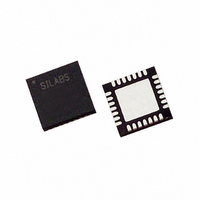C8051F321R Silicon Laboratories Inc, C8051F321R Datasheet - Page 183

C8051F321R
Manufacturer Part Number
C8051F321R
Description
IC 8051 MCU 16K FLASH 28MLP
Manufacturer
Silicon Laboratories Inc
Series
C8051F32xr
Datasheet
1.C8051F320R.pdf
(256 pages)
Specifications of C8051F321R
Core Processor
8051
Core Size
8-Bit
Speed
25MHz
Connectivity
SMBus (2-Wire/I²C), SPI, UART/USART, USB
Peripherals
Brown-out Detect/Reset, POR, PWM, Temp Sensor, WDT
Number Of I /o
21
Program Memory Size
16KB (16K x 8)
Program Memory Type
FLASH
Ram Size
2.25K x 8
Voltage - Supply (vcc/vdd)
2.7 V ~ 3.6 V
Data Converters
A/D 13x10b
Oscillator Type
Internal
Operating Temperature
-40°C ~ 85°C
Package / Case
28-VQFN Exposed Pad, 28-HVQFN, 28-SQFN, 28-DHVQFN
Lead Free Status / RoHS Status
Contains lead / RoHS non-compliant
Eeprom Size
-
Other names
336-1067-2
- Current page: 183 of 256
- Download datasheet (4Mb)
C8051F320/1
16.4.2. SMB0CN Control Register
SMB0CN is used to control the interface and to provide status information (see Figure 16.6). The higher four bits of
SMB0CN (MASTER, TXMODE, STA, and STO) form a status vector that can be used to jump to service routines.
MASTER and TXMODE indicate the master/slave state and transmit/receive modes, respectively.
STA and STO indicate that a START and/or STOP has been detected or generated since the last SMBus interrupt.
STA and STO are also used to generate START and STOP conditions when operating as a master. Writing a ‘1’ to
STA will cause the SMBus interface to enter Master Mode and generate a START when the bus becomes free (STA is
not cleared by hardware after the START is generated). Writing a ‘1’ to STO while in Master Mode will cause the
interface to generate a STOP and end the current transfer after the next ACK cycle. If STO and STA are both set
(while in Master Mode), a STOP followed by a START will be generated.
As a receiver, writing the ACK bit defines the outgoing ACK value; as a transmitter, reading the ACK bit indicates
the value received on the last ACK cycle. ACKRQ is set each time a byte is received, indicating that an outgoing
ACK value is needed. When ACKRQ is set, software should write the desired outgoing value to the ACK bit before
clearing SI. A NACK will be generated if software does not write the ACK bit before clearing SI. SDA will reflect
the defined ACK value immediately following a write to the ACK bit; however SCL will remain low until SI is
cleared. If a received slave address is not acknowledged, further slave events will be ignored until the next START is
detected.
The ARBLOST bit indicates that the interface has lost an arbitration. This may occur anytime the interface is trans-
mitting (master or slave). A lost arbitration while operating as a slave indicates a bus error condition. ARBLOST is
cleared by hardware each time SI is cleared.
The SI bit (SMBus Interrupt Flag) is set at the beginning and end of each transfer, after each byte frame, or when an
arbitration is lost; see Table 16.3 for more details.
Important Note About the SI Bit: The SMBus interface is stalled while SI is set; thus SCL is held low, and the bus
is stalled until software clears SI.
Table 16.3 lists all sources for hardware changes to the SMB0CN bits. Refer to Table 16.4 for SMBus status decoding
using the SMB0CN register.
Rev. 1.1
183
Related parts for C8051F321R
Image
Part Number
Description
Manufacturer
Datasheet
Request
R
Part Number:
Description:
SMD/C°/SINGLE-ENDED OUTPUT SILICON OSCILLATOR
Manufacturer:
Silicon Laboratories Inc
Part Number:
Description:
Manufacturer:
Silicon Laboratories Inc
Datasheet:
Part Number:
Description:
N/A N/A/SI4010 AES KEYFOB DEMO WITH LCD RX
Manufacturer:
Silicon Laboratories Inc
Datasheet:
Part Number:
Description:
N/A N/A/SI4010 SIMPLIFIED KEY FOB DEMO WITH LED RX
Manufacturer:
Silicon Laboratories Inc
Datasheet:
Part Number:
Description:
N/A/-40 TO 85 OC/EZLINK MODULE; F930/4432 HIGH BAND (REV E/B1)
Manufacturer:
Silicon Laboratories Inc
Part Number:
Description:
EZLink Module; F930/4432 Low Band (rev e/B1)
Manufacturer:
Silicon Laboratories Inc
Part Number:
Description:
I°/4460 10 DBM RADIO TEST CARD 434 MHZ
Manufacturer:
Silicon Laboratories Inc
Part Number:
Description:
I°/4461 14 DBM RADIO TEST CARD 868 MHZ
Manufacturer:
Silicon Laboratories Inc
Part Number:
Description:
I°/4463 20 DBM RFSWITCH RADIO TEST CARD 460 MHZ
Manufacturer:
Silicon Laboratories Inc
Part Number:
Description:
I°/4463 20 DBM RADIO TEST CARD 868 MHZ
Manufacturer:
Silicon Laboratories Inc
Part Number:
Description:
I°/4463 27 DBM RADIO TEST CARD 868 MHZ
Manufacturer:
Silicon Laboratories Inc
Part Number:
Description:
I°/4463 SKYWORKS 30 DBM RADIO TEST CARD 915 MHZ
Manufacturer:
Silicon Laboratories Inc
Part Number:
Description:
N/A N/A/-40 TO 85 OC/4463 RFMD 30 DBM RADIO TEST CARD 915 MHZ
Manufacturer:
Silicon Laboratories Inc
Part Number:
Description:
I°/4463 20 DBM RADIO TEST CARD 169 MHZ
Manufacturer:
Silicon Laboratories Inc










